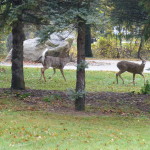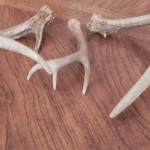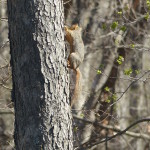by Winding Pathways | Nov 2, 2015 | Mammals, Nature, Pests

On Halloween day a buck was hot on the “tail” of this doe and yearling.
Drivers, be cautious! Across most of North America early November is the most likely time for a car to collide with a deer. Too often it happens even in suburban neighborhoods and a collision usually does extensive damage to a car, injures or kills the deer, and sometimes even people are killed or hurt.
At our home at Winding Pathways we watched a buck chase a doe on Halloween afternoon. That’s slightly early, but during the next two weeks more cars will hit deer than in any other time period in the year.
In early November female deer come into estrus in northern states with peak activity a week or two later in the south. Big antlered bucks have the uncanny ability to stay out of sight most of the year, but in November they abandon caution and run through backyards and cross roads at any time of day or night. A doe in heat is usually followed closely by an eager buck.
Within weeks nearly all does will be pregnant and the rut fades, but usually it’s followed by a somewhat less intense breeding time in about a month when any nonpregnant does mate. By Christmas nearly all does are pregnant and will give birth late next spring.
When driving through deer territory always be careful, but in early November be especially cautious. Go easy on the gas pedal, keep your eyes open and if one deer crosses the road in front of you expect others to follow. Look in the direction the deer came from. Others likely will be about to cross.
An interesting overview on deer rutting can be found at The Noble Foundation.
by Winding Pathways | Sep 12, 2015 | Mammals, Nature, Pests, Trees/Shrubs

A pair of winter sheds all polished.
One year at Winding Pathways we planted a few trees and tended them all summer. They were doing great until one September night. A buck deer decided that our new trees were perfect for rubbing off the velvet that covered his newly formed antlers. Just a few minutes of determined rubbing killed our precious trees!
Deer antlers start growing in early spring and by late August are fully formed. Velvet on the outside of the growing antlers is rich with blood and minerals. By September its purpose is done. Bucks rub the velvet off to prepare their antlers for battle with rivals when the mating season starts in November.
Deer have the uncanny knack of rubbing the most valued trees in a yard, and often they remove all the bark, thus killing the tree.
Fortunately, damage is easy to prevent. Just drive fence posts into the ground a few feet out from the tree and attach wire mesh to them to physically keep deer away. Plastic tree guards that attach directly to the trunk also help prevent damage.
Do this now before the deer start to rub. Or you may lose all your new trees in just one night.
by Winding Pathways | Jul 17, 2015 | Mammals, Nature, Pests
Chipmunks are one of the most common backyard wild animals. These small striped rodents enjoy living in shady yards that have some form of structure for them to hide in or around. Sometimes people confuse them with thirteen lined ground squirrels, which are about the same size but prefer to live in large lawns in the open sun.
Several species of chipmunks live in the United States. Most are in the West and the most commonly encountered species is the Eastern Chipmunk that frequent yards.
Chipmunks love retaining walls and woodpiles, especially those that have many nooks and crannies. They are efficient diggers and sometimes make so many tunnels that a wall slumps or collapses and a woodpile teeters over.
The small mammals eat seeds, fruit, and an occasional insect. They are efficient tree climbers and harvest fruits like cherries on the uppermost slender branches. Chipmunk heaven is a shady yard with a retention wall and bird feeder to provide a daily seed banquet.
Some people resent chipmunks because of their incessant tunneling. Box trapping and moving the animals rarely reduces the population of a species that has many babies. Keeping bird seed off the ground and contained in feeders may reduce a chipmunk population somewhat. Hawks and snakes enjoy dining on these small mammals. Encouraging predators to share the yard will help keep chipmunk numbers in check.
We like the chipmunks that live in our backyard at Winding Pathways. They’re beautiful animals that make us smile when we spot one with cheek pouches crammed with seeds. They’ve undermined our low rock wall in a few places, but we just repair it and consider the damage a small price to pay for the wonderful entertainment chipmunks provide on summer days.
by Winding Pathways | May 1, 2015 | Mammals, Nature
Squirrels are probably North America’s most acrobatic animals. They’re able to do seemingly impossible physical maneuvers.

Squirrels “wrists” articulate so they can climb agiley up and down.
One is hanging by their rear toes to snatch seeds from a hanging feeder. How do they do it?
Raccoons and house cats can climb up trees fairly rapidly but descending back to earth is a problem. Both must creep down tail first. It’s awkward and slow.
Squirrels, in contrast, can go up and down head first quickly and gracefully thanks to a special adaptation. Their ankles, or wrists, articulate. The squirrel may be heading down the trunk but its feet and claws point upward, enabling a good grip on the bark and a speedy dexterous descent.
Squirrels are outstanding tree climbers but once in a while they slip and fall. Twice at Winding Pathways we’ve seen squirrels fall from the top of big oaks. As they fall the hapless animals flattened themselves out and hit the ground like a swimmers belly flop. In both cases the animals shook themselves, looked around and scampered off unhurt. Imagine what would happen to a human falling 50 feet!
Next time you spot a squirrel hanging from a feeder or scampering down a tree examine its feet through binoculars. You may see upward facing feed on a downward facing animal. You Tube has some great close ups of squirrels paws and wrists. Enjoy the show!
by Winding Pathways | Feb 2, 2015 | Mammals, Nature
Relatively warm snow free winters make life easier for most species of wildlife. Deer, raccoons, wild turkeys, pheasants and other animals easily move around and find food on bare ground.
The pocket gopher is an exception. It prefers deep snow. During warm months this common animal tunnels through the soil seeking roots that form the bulk of its diet. Cold weather makes the ground as hard as armor plate. Since tunneling in frozen dirt is nearly impossible a hungry gopher must emerge above ground to find food.
That’s not a problem if there’s a heavy snow cover that enhances gopher safety. Few animals are as tasty to a hawk or owl as a plump gopher, but when the animals are under the snow they are invisible to even these keen eyed predators. During snow free winters a gopher foraging on the surface stands good odds of becoming a raptor’s lunch.
Snow probably doesn’t protect gophers from mammalian predators like red foxes or coyotes. These members of the dog family can detect movement and smell the tasty gopher trying to hide in the snow. They happily convert the hapless gopher into a meal.
As snow melts people sometimes find gopher snow tunnels, which often melt a little slower than surrounding snow.
by Winding Pathways | Dec 29, 2014 | Mammals, Nature
Every winter the residents of urbanized areas are astonished to spot massively antlered buck deer in broad daylight. These large animals haven’t just moved to town. They’ve been here all along. Unlike does and fawns, bucks are exceedingly secretive and are rarely spotted as they hide in tiny urban wooded areas and even prairies. However, during the main mating season in November and a secondary one in December bucks lose their caution and may be spotted in even the most urban areas. Also, all deer are more visible in winter than summer because leaves have dropped and snow covers the ground.
Sometimes an area’s largest bucks reside in towns for a number of reasons. Often cities have nutritious food interspersed with woods and ravines that provide secluded hiding places. Hunters usually prefer to shoot large bucks, and in rural areas these often become steaks and chops before they fully mature. Most city bucks are well nourished and, provided they survive highway collisions, are more likely to live longer and grow bigger antlers than their rural cousins.Well-nourished five and six year old bucks normally have the largest antlers but beyond these years their antlers decline as part of the aging process.
Today many cities allow bow hunting to trim deer damage to vegetation and reduce vehicle collisions. Usually hunters are required to shoot does, which allows urban bucks grow old and large.
Every year, usually in March or April but sometimes as early as December, bucks shed their antlers. By late April they begin growing new ones. So, the very large antlerless deer spotted in late winter could be a buck. Hunting shed antlers in late winter is becoming a popular activity.
Although big bucks live near people all year, winter is a great season to observe them.



